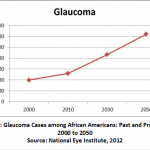
Glaucoma cases among African Americans to increase 66 percent by 2030
As you and your loved ones watch the dawning of 2013, everyone is hopeful of what the new year will bring—reunions, graduations, marriages, and other fun family occasions. January is Glaucoma Awareness Month. Make seeing your best a part of your new beginning by doing what you can to make sure your eyes are healthy. If you are African American age 40 or older or have a family history of glaucoma, put learning more about this disease on your resolution list for the new year.
There has been a steady rise in glaucoma among the African American community. Currently, more than 520,000 African Americans have glaucoma, and the National Eye Institute (NEI) of the National Institutes of Health projects this number will rise to approximately 865,000 cases by 2030, a 66 percent increase. African Americans have the highest prevalence of glaucoma among minority groups. Last year, NEI invested $71 million on a wide range of studies to understand causes and potential areas of treatment for glaucoma.
Glaucoma is a group of diseases that can damage the optic nerve of the eye and result in vision loss and blindness. Primary open-angle glaucoma is the most common form. In this condition, fluid builds up in the front chamber of the eye, and the optic nerve is damaged by the resulting increase in eye pressure.
“Glaucoma affects more than 2.7 million people nationwide and is a leading cause of vision loss and blindness in African Americans. In fact, African Americans are at risk of developing it at an earlier age than other racial and ethnic groups,” said Dr. James Tsai, chair of the Glaucoma Subcommittee for the NEI National Eye Health Education Program. “Primary open-angle glaucoma often has no early symptoms. However, as the disease progresses, a person may eventually notice his or her side vision decreasing. If the disease is left untreated, the field of vision narrows and vision loss may result.”
“Studies show that at least half of all persons with glaucoma don’t know they have this potentially blinding eye disease,” said NEI director Dr. Paul Sieving. “The good news is that glaucoma can be detected in its early stages through a comprehensive dilated eye exam. NEI encourages all people at higher risk of glaucoma—African Americans age 40 or older; everyone age 60, especially Mexican Americans; and those with a family history—to get a dilated eye exam every one to two years, because early detection and timely treatment may save your sight.”
During a comprehensive dilated eye exam, drops are placed in your eyes to dilate, or widen, the pupils. This allows your eye care professional to see inside your eye and examine the optic nerve for signs of glaucoma and other vision problems. A test for eye pressure alone is not enough to detect glaucoma. “It’s very important that people don’t wait until they notice a problem with their vision to have an eye exam,” adds Dr. Tsai.
If you have Medicare, are African American age 50 or older, have diabetes, or have a family history of glaucoma, you may be eligible for a low-cost, comprehensive dilated eye exam through the glaucoma benefit. Call 1–800–MEDICARE or visit http://www.medicare.gov for more information. To find out about other possible financial assistance for eye care, visit http://www.nei.nih.gov/health/financialaid.asp.
It’s a new year, so make sure you and your family start it off right. Keep vision in your future. For more information about glaucoma, visit http://www.nei.nih.gov/glaucoma or call NEI at 301–496–5248.










